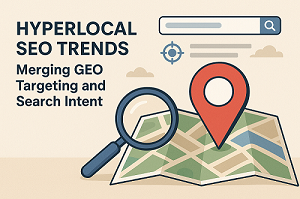In the rapidly evolving world of digital marketing, businesses must now go beyond traditional local SEO techniques to remain visible and competitive. As user behavior changes and search engines get smarter, a new trend has emerged: hyperlocal SEO. This approach blends GEO targeting with search intent to create highly personalized, location-specific strategies that connect businesses with nearby consumers exactly when they’re searching.
Whether you’re a neighborhood café, a boutique service provider, or a multi-location brand, understanding how to leverage hyperlocal SEO can help you dominate search results at the local level. In this blog, we’ll explore what hyperlocal SEO means, how it works, and what trends are shaping its future.
What is Hyperlocal SEO?
Hyperlocal SEO refers to the optimization of your online presence for very specific geographic locations—down to neighborhoods, streets, or even blocks. Unlike general local SEO, which targets broader regions like cities or metro areas, hyperlocal SEO zooms in on the exact spots where potential customers live, work, and search.
For example, instead of targeting “dentist in Mumbai,” a hyperlocal strategy would aim for “dentist near Bandra West station” or “emergency dental clinic on Linking Road.” This level of precision helps your business appear in ultra-targeted searches, which are often high in intent and conversion-ready.
Why GEO Targeting + Search Intent Matters
Search engines have evolved to prioritize user intent—what the searcher is actually looking to do. At the same time, mobile devices and location-based technology have made it easier to identify exactly where the search is coming from. The merging of these two factors has given rise to hyperlocal SEO.
For instance, someone searching for “best pizza near me” isn’t just looking for pizza—they want it fast, close, and with good reviews. If your restaurant is optimized for both location (GEO targeting) and search intent (delivery, dine-in, quick service), you have a better chance of appearing at the top of their search.
This blend is especially crucial for brick-and-mortar businesses competing with large chains. Hyperlocal strategies allow them to outshine competitors by offering relevance, proximity, and value—exactly what users and search engines are looking for.
Key Trends Driving Hyperlocal SEO
1. Voice Search Optimization
As more users rely on smart assistants like Siri, Alexa, and Google Assistant, voice search is shaping local SEO. Voice queries tend to be conversational and often include location-based questions like “Where’s the nearest tire repair shop?”
To stay competitive, businesses need to:
- Use natural language in content
- Answer common questions (FAQs)
- Optimize for long-tail, location-specific keywords
2. Zero-Click Searches and Local Packs
Google now provides many answers directly in the search results via features like the Local Pack, Featured Snippets, and Maps previews. In hyperlocal SEO, it’s essential to optimize your Google Business Profile, ensure NAP (Name, Address, Phone) consistency, and gather local reviews.
Being in the Local Pack significantly increases visibility, especially for mobile users ready to make quick decisions.
3. Localized Content Marketing
Content still reigns supreme, but it must now be locally relevant. Blog posts, service pages, and landing pages should target specific neighborhoods or districts. Examples:
- “5 Must-Visit Cafes in Indiranagar, Bangalore”
- “How Our Delhi-Based Clients Benefit from Hyperlocal SEO”
This localized content helps attract users searching for solutions in specific areas and enhances topical authority within your niche.
How to Merge GEO Targeting and Search Intent Effectively
To successfully implement a hyperlocal SEO strategy, follow these best practices:
1. Optimize for ‘Near Me’ Searches
Include keywords like “near me,” “close by,” or specific landmarks in your titles, descriptions, and content. These searches have strong purchase intent and are often used by people on the go.
2. Leverage Google Business Profile Features
Your Google Business Profile is a cornerstone of hyperlocal SEO. Make sure to:
- Update your location, hours, and services regularly
- Add high-quality photos
- Encourage and respond to local reviews
- Post updates and offers
3. Create Geo-Specific Landing Pages
If your business serves multiple neighborhoods or regions, create separate pages for each. Customize content for each area, including local testimonials, images, and service offerings.
4. Use Hyperlocal Schema Markup
Implement structured data that includes geolocation details, business hours, and service areas. This helps search engines better understand your content and increases the chances of appearing in rich results.
The Role of SEO Services in Hyperlocal Strategies
Many businesses turn to SEO services in Abu Dhabi to help navigate the complex landscape of hyperlocal optimization. These services often include technical audits, content creation, local link building, and performance tracking—all tailored to specific geographic targets. With search engine algorithms frequently changing, professional SEO support ensures that your strategy stays relevant and effective.
Furthermore, SEO agencies bring valuable insights from working with various industries and regions, helping you avoid common pitfalls and focus on what drives real results.
As consumers increasingly rely on mobile devices and location-based searches, the importance of hyperlocal SEO continues to grow. By merging GEO targeting with search intent, businesses can create personalized, relevant experiences that meet users exactly where they are—both physically and mentally.
From optimizing your Google Business Profile to creating locally-driven content, every small effort adds up in the hyperlocal game. And while the strategy may be niche-focused, the impact can be massive.
To truly stand out in your neighborhood or service area, consider investing in customized SEO services in Sharjah that understand the nuances of hyperlocal search. Because in today’s search landscape, being local isn’t just an advantage—it’s a necessity.
- Hyperlocal SEO Trends: Merging GEO Targeting and Search Intent
- Discover how hyperlocal SEO trends merge GEO targeting with search intent to boost local visibility and drive more relevant traffic.
- SEO, Digital marketing
Related posts:
 Best Website Designer and Web Design Solutions with Cyberworx Technologies
Best Website Designer and Web Design Solutions with Cyberworx Technologies
 Enjoy Ultra 9000 Box of 10 – Power, Flavour, and Convenience Combined
Enjoy Ultra 9000 Box of 10 – Power, Flavour, and Convenience Combined
 Crystal Pro Max + 10000 Box of 10: Long-Lasting Flavour from a Trusted Vape Store in UK
Crystal Pro Max + 10000 Box of 10: Long-Lasting Flavour from a Trusted Vape Store in UK
 Outrank Competitors with Help from a Trusted Denver SEO Agency
Outrank Competitors with Help from a Trusted Denver SEO Agency
 Marathi Birthday Invitation Card Maker Free – Design Stunning Invites Online
Marathi Birthday Invitation Card Maker Free – Design Stunning Invites Online
 Best Inter Colleges In Hyderabad | Shamshabad – Accomplish Academy
Best Inter Colleges In Hyderabad | Shamshabad – Accomplish Academy
 Gojek Clone: Launch a Successful All-In-One Service Platform in 2025
Gojek Clone: Launch a Successful All-In-One Service Platform in 2025
 Discover Expert Massage Therapy Near New Hope with BetterHealthConcept
Discover Expert Massage Therapy Near New Hope with BetterHealthConcept








